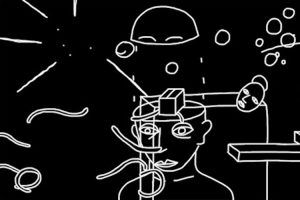The Impact of Higgs Boson Discovery
Physicist Jonathan Butterworth on the predictions of the Standard Model, new excitement about physics and futu...
The video is a part of the project British Scientists produced in collaboration between Serious Science and the British Council.
Studies of social cognition emerged more or less at the end of the 20th Century. And, interestingly and coincidently so did the possibility of studying how the brain works. I was lucky enough to be involved in the development of neuroimaging from its earliest days which were in the late 1980s, which started with PET scanning and then went on to functional MRI, which is a way in both of these methods are ways of looking at the living, healthy human brain and asking which bits of it become active when you are doing certain tasks. And, because I was involved in imaging from the very start I was also involved in studying social cognition using brain imaging from the very start. And, for example, you can put people in a scanner, you can show them faces and you can see which bits of the brain light up, as we call it. One of the early studies I was involved in is looking at what happens when you see a fearful face. And, we found, and others have found it too, that a particular bit of the brain called the amygdala, which is deep inside the anterior temporal lobe, lights up when you see a fearful face. And indeed, when you see a fearful face you also feel a bit fearful yourself and you get a similar [response]. So that your amygdala responds to all sorts of fear-inducing stimuli, including fearful faces. And interestingly, it will light up even if the face is presented so quickly and if it’s masked by a face with a neutral expression so that you are unaware of seeing the fearful expression. The amygdala will still light up. So, this was one of the things, and this is an important finding in talking about the neural basis of social cognition.
I was involved, again working with brain imaging machines, where we could show similar effects in people. Although now of course we are not looking at single neurons, you are looking at thousands of neurons. But, I think it’s fairly well-established that there is a similar system of mirrors system in people. And you can also show that it’s not just for actions like picking up peanuts but it’s for emotions as I was saying earlier about fear. So when you see fear, you feel fear. When you see someone’s face being touched, you actually feel it in your own face. Not consciously, but the relevant bit of the brain is activated that would be activated if your own face was touched. So, there are many of these mirror systems. In the early days after mirror neurons were discovered people I think rightly became very excited but they somewhat exaggerated what they thought these neurons might be doing. So, there are two questions. First of all, you have the question how is it, how do you solve what is called the correspondence problem? That is to say, the relationship between seeing an action and performing an action. How can activity in the visual system be converted into activity in the motor system, or are there no direct connections? And, in a sense mirror reveal that the brain does this, but they don’t tell you how the brain does it. This became extremely interesting to everybody. And the other problem was the early response to mirror neurons – people said: this explains how we can read other people’s minds. Or in a more simple way, when we see someone acting, we can automatically work out what their goal is, what their intentions are, why they are doing this. And the further research, of course, showed that life is much more complicated than that.
But, there are now quite interesting attempts to solve some of these problems. So, the first question is how do you get the relationship between seeing an action and performing an action. And one current idea is that this is done by association learning which is a fundamental property of what the brain does, going right back to Pavlov. You know, hearing the bell conditions the dog to salivate in the same way we would see, seeing the hand moving conditions you to feel like what it would be to move your own hand. And of course, we do constantly see our own hands moving so that we can build up the association. And very young infants spend a lot of their time waving their hands about in front of their eyes, which is probably again building up this association and creating the possibility of mirror neurons. The other problem though is how do you link, how can you work out by looking at someone or talking to someone for that matter what their intentions are, what their beliefs are? This is sometimes known as Theory of Mind, or mentalizing – the ability to read minds.
Now, going back to brain imaging, again, one of the very early studies that we did at the end of the 20th Century was to put people in a scanner and give them problems to solve which involved thinking about what another was thinking about. The very basic task which was developed in children is the Sally-Anne task, which my wife, Uta Frith, was involved with. Where you have to recognize that Sally will look in the place where she believes the marble is and not where it actually is. So, beliefs are what counts in predicting somebody’s behavior. And you can put someone in a scanner and present them with problems a bit like the Sally task, and predict like where will she look, and you can show that particular brain regions are activated when you perform this kind of task which involves thinking about other people’s mental states. Or even thinking about your own mental states. And interestingly these are not the same areas as the areas where the mirror neurons are found. So, it seems to be a different system.
I think, I would still have to confess that we still don’t really know what these brain areas are doing and what the mechanisms are, but we have some ideas. So, if we have considered the problem of working out someone’s intentions from their actions. A simple version of how you might read someone’s intentions from their actions is you see the action and your mirror neuron system works out what you would be doing, why you would be doing such an action and that gives you the goal. But there is a problem, and the analogy is with the story of Doctor Jekyll and Mister Hyde. So Dr. Jekyll is a good surgeon who cures people; Mr. Hyde, who is the alter ego of Dr. Jeckyll is an evil person who wants to harm people. So, if you see this person who looks identical, holding a scalpel and cutting someone. how do you know whether it is Mr. Hyde being nasty, or Dr. Jeckyll being kind? The solution to this is to say you have to have some prior idea of who you are looking at. Or you have some prediction of why this person is doing what he is doing. So, it’s not enough just to see the action, you have to have some expectation of why the person is acting like that, on the basis of which you can predict precisely what they would do next. And if they do something different from what you expect, you have to update your expectation of why they were doing this. So, this is how we are currently thinking about how the brain solves these mentalizing problems and, for example, the temporoparietal junction seeks to have an important role in mentalizing and this seems to be an area that is interested in what the intentions are of the person you are observing and becomes particularly excited if they do something different than what you expect, which we would call it a prediction error, which is crucial in working out precisely why they are doing what they are doing.
Neuroimaging had a big impact on the study of social cognition, because it revealed discreet brain areas concerned with particular aspects of social cognition like emotion expression. But, I think the biggest impact of course was the discovery of mirror neurons, and that there are many aspects of social cognition that involve mirroring. And one of these is emotional expressions. So, when we see someone with an emotional expression we tend to mirror this. If I see someone with a happy expression, I will to some extent feel happy. And this of course people became very excited about because it provides perhaps a neural basis for empathy.

Physicist Jonathan Butterworth on the predictions of the Standard Model, new excitement about physics and futu...

Epidemiologist Nick Wareham on leptin, type 2 diabetes, and genome-wide association studies

Neuroscientist Klaus Linkenkaer-Hansen on the biology of mind-wandering, training one's attention, and the rol...